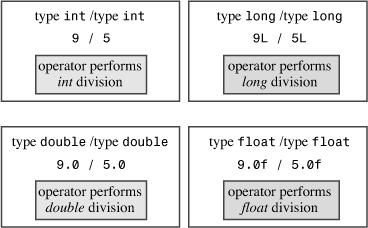Division Diversions
You have yet to see the rest of the story about the division operator (/). The behavior of this operator depends on the type of the operands. If both operands are integers, C++ performs integer division. That means any fractional part of the answer is discarded, making the result an integer. If one or both operands are floating-point values, the fractional part is kept, making the result floating-point. Listing 3.11 illustrates how C++ division works with different types of values. As in Listing 3.10, Listing 3.11 invokes the setf() member function to modify how the results are displayed.
// divide.cpp -- integer and floating-point division
#include <iostream>
int main()
{
using namespace std;
cout.setf(ios_base::fixed, ios_base::floatfield);
cout << "Integer division: 9/5 = " << 9 / 5 << endl;
cout << "Floating-point division: 9.0/5.0 = ";
cout << 9.0 / 5.0 << endl;
cout << "Mixed division: 9.0/5 = " << 9.0 / 5 << endl;
cout << "double constants: 1e7/9.0 = ";
cout << 1.e7 / 9.0 << endl;
cout << "float constants: 1e7f/9.0f = ";
cout << 1.e7f / 9.0f << endl;
return 0;
}
Here is the output from the program in Listing 3.11 for one implementation:
Integer division: 9/5 = 1
Floating-point division: 9.0/5.0 = 1.800000
Mixed division: 9.0/5 = 1.800000
double constants: 1e7/9.0 = 1111111.111111
float constants: 1e7f/9.0f = 1111111.125000
The first output line shows that dividing the integer 9 by the integer 5 yields the integer 1. The fractional part of 4 / 5 (or 0.8) is discarded. (You’ll see a practical use for this kind of division when you learn about the modulus operator, later in this chapter.) The next two lines show that when at least one of the operands is floating-point, you get a floating-point answer of 1.8. Actually, when you try to combine mixed types, C++ converts all the concerned types to the same type. You’ll learn about these automatic conversions later in this chapter. The relative precisions of the last two lines show that the result is type double if both operands are double and that it is float if both operands are float. Remember, floating-point constants are type double by default.

